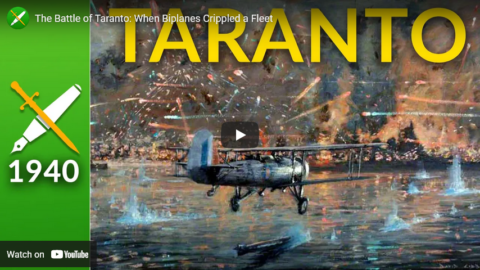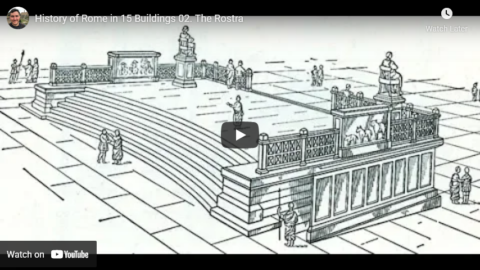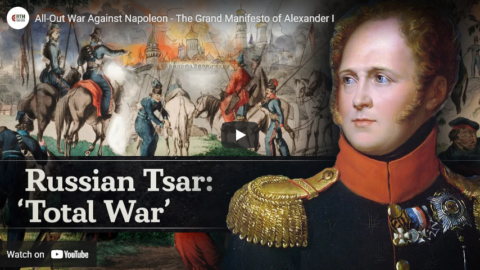Historigraph
Published 23 Feb 2019If you enjoyed this video and want to see more made, consider supporting my efforts on Patreon: https://www.patreon.com/historigraph
#BattleOfTaranto #Historigraph
► Twitter: https://twitter.com/historigraph
► Instagram: https://www.instagram.com/historigraph
► My Gaming Channel: https://www.youtube.com/c/Addaway
► My Twitch: https://www.twitch.tv/addaway
March 28, 2022
The Battle of Taranto: When Biplanes Crippled a Fleet
QotD: The evolution of tanks through World War 2
One interesting thing about tank evolution that never gets mentioned in America is just how good the Soviets were at making tanks. The Germans are always assumed to have been the great tank builders, followed by the Americans, but it was the Russians who dominated the field in the tank game. Russian tanks were fast, powerful and easy to operate by their crews. Most important, they were reliable in all weather. The Russians assumed they would be fighting in horrible conditions and built a tank for it.
The Germans, in contrast, made one error after another when it came to tank design and tank building. They were obsessed with coming up with the biggest, most powerful tank, rather than making lots of good enough tanks. The result was lots of innovative designs, but most were failures and there was never enough of them. The Panzer IV was a very good tank with a platform that was flexible, but the Germans kept trying to come up with a super tank, rather than make lots of these. That was a costly error.
The American tank, which was used by the British, was not a great tank, but they were cheap and reliable, which meant there were loads of them. It was also a flexible platform for all sorts of other uses. The Sherman tank was about using the two advantages the Americans had over the Germans. One was more industry and the other was more soldiers. The plan was to beat the Germans with volume. While it would take five Sherman tanks to take out a German tank, that was math that worked in favor of the Americans.
This conflict between the perfect and the good enough showed up in many places during the war. The Germans seemed to look at the whole thing as an engineering project. The first step was to accept the restraints and then solve for the variables. The Russian and American view was always to limit the constraints and thereby increase the number of possible right answers. The Germans had much better human capital, but their opponents always had many more choices. They also had numbers, which counts for a lot.
The Z Man, “Tanking It”, The Z Blog, 2019-03-01.
March 27, 2022
American Army Finally Does Something Right – WW2 – 187 – March 26, 1943
World War Two
Published 26 Mar 2021The British are attacking the Mareth Line in North Africa while the Americans hit the Axis flank, but the Allies are withdrawing in Burma. It’s the Germans who are pulling back in the USSR, though, and there is another attempt from within German Command to assassinate Adolf Hitler.
(more…)
The zombie Russian empire under Tsar Vladimir I
In the most recent Weekly Dish, Andrew Sullivan looks at the quasi-Imperial goals of Vladimir Putin:
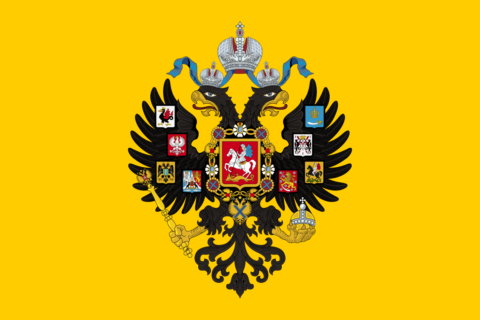
Imperial Standard of the Emperor of Russia, used from 1858 to 1917.
Image by Trajan 117 via Wikimedia Commons.
“The huge iceberg Russia, frozen by the Putin regime, cracked after the events in Crimea; it has split from the European world, and sailed off into the unknown,” – Vladimir Sorokin, New York Review of Books, 2017.
The greatest mistake liberals make when assessing reactionaryism is to underestimate it. There is a profound, mesmerizing allure — intensified by disillusion with the shallows of modernity — to the idea of recovering some great meaning from decades or centuries gone by, to resurrect and resuscitate it, to blast away all the incoherence and instability of post-modern life into a new collective, ancient meaning.
Even when it’s based on bullshit. You’d be amazed how vacuous slogans about returning to a mythical past — “Make America Great Again!”, “Take Back Control!” — can move public opinion dramatically in even the most successful modern democracies. That’s one reason it’s self-defeating for liberals to press for maximal change in as many things as possible. National identity, fused often with ethnic heritage, has not disappeared in the human psyche — as so many hoped or predicted. It has been reborn in new and strange forms. Now is the time of monsters, so to speak. Best not to summon up too many.
This, it seems to me, is what many of us have missed about the newly visible monster of post-Communist Russia. It would be hard to conjure up a period of post-modern bewilderment more vividly than Russia in the post-Soviet 1990s. A vast empire collapsed overnight; an entire totalitarian system, long since discredited but still acting as some kind of social glue and cultural meaning, unraveled in chaos and confusion.
Take away a totalitarian ideology in an instant, and a huge vacuum of meaning will open up, to be filled by something else. We once understood this. When Nazi Germany collapsed in total military defeat, the West immediately arrived to reconstruct the society from the bottom up. We de-Nazified West Germany; we created a new constitution; we invested massively with the Marshall Plan, doing more for our previous foe than we did for a devastated ally like Britain. We filled the gap. Ditto post-1945 Japan.
But we left post-1991 Russia flailing, offering it shock therapy for freer markets, insisting that a democratic nation-state could be built — tada! — on the ruins of the Evil Empire. We expected it to be reconstructed even as many of its Soviet functionaries remained in place, and without the searing experience of consciousness-changing national defeat. What followed in Russia was a grasping for coherence, in the midst of national humiliation. It was more like Germany after 1918 than 1945. It is no surprise that this was a near-perfect moment for reactionism to stake its claim.
It came, like all reactionary movements, not from some continuous, existing tradition waiting to be tweaked or deepened, but from intellectuals, making shit up. They created a near-absurd mythology they rescued from the 19th and early 20th centuries — packed with pseudo-science and pseudo-history. Russia was not just a nation-state, they argued; it was a “civilization-state”, a whole way of being, straddling half the globe and wrapping countless other nations and cultures into Mother Russia’s spiritual bosom. Russians were genetically different — infused with what the reactionary theorist Lev Gumilev called “passionarity” — a kind of preternatural energy or will to power. They belonged to a new order — “Eurasia” — which would balance the Atlantic powers of the US and the UK, and help govern the rest of the world.
Book Review: The Uzi Submachine Gun Examined, by David Gaboury
Forgotten Weapons
Published 13 Aug 2017The UZI Submachine Gun: Examined is a newly published book this year by David Gaboury — long time owner and operator of the uzitalk.com forum. Until now there has not really been any substantive written reference material on the Uzi, but Gaboury has certainly changed that!
The Uzi has not really seen many major variations in its design beyond the Uzi/Mini Uzi/Micro Uzi scaling (and the semiauto and full auto variations of each), but it has lived two rather distinct lives. One is the Uzi as a global military arm, and the other is the Uzi as an American commercial product — and this book covers both in excellent detail.
On the military side, the book begins with a substantial chapter on the initial development of the Uzi and Israeli submachine gun trials. A remarkably wide variety of guns were considered by the Israeli armed forces, and the trial ultimately came down to two domestic designs. The influence of the Czech ZK-476 and SA vz 23/4/5/6 designs are well explained, and much of the mythology about where the design came from is dispelled. Gaboury makes good use of both original documentary sources and firsthand conversation with those who were involved at the time to tell this story.
With the gun accepted, in production, and becoming very popular with Israeli troops, international sales become a possibility. Gaboury covers the adoption of the gun by the Dutch armed forces, followed by the German and South African militaries — as well as the licensed production by FN. He also examines other copies and adaptations, including Croatian, Japanese, and Chinese.
The second half of the Uzi story is that of its sale in the United States (including the use by US security organizations including the Secret Service). This is a story every bit as complex and detailed as the international military use of the gun, as US legal changes in 1968, 1986, 1989, 1994, and 2004 all play a major role in dictating changes that must be made to the guns for import and sale. In particular, Gaboury has detailed chapters on the major sellers of Uzis in the US — Action Arms, Group Industries, and Vector Arms (as well as many other smaller players).
While there may not be many major variations of the Uzi, there are a multitude of smaller changes to individual parts in both design and production technique, and Gaboury covers these in remarkable detail. If there is a flaw to the book, it is not in lack of detail, but perhaps in a bit of dryness to the writing. The information is clearly presented, but not particularly engaging to the reader who is only mildly interested in the subject. This is a minor criticism, however, and the book is an outstanding reference for anyone who has, well, really any questions at all about the Uzi.
http://www.patreon.com/ForgottenWeapons
Cool Forgotten Weapons merchandise! http://shop.bbtv.com/collections/forg…
If you enjoy Forgotten Weapons, check out its sister channel, InRangeTV! http://www.youtube.com/InRangeTVShow
QotD: Period culture in old movies and TV shows
From the vantage point of the 1970’s, “old” TV shows were mostly things from the 1960’s, but old movies from the 40’s and 50’s were common too. In other words, if you wanted to peek back in time to the previous eras of American culture, you could reliably go back a decade and selectively go back a few decades. Bad old TV shows like Get Smart and Star Trek would go into syndication, but bad old movies were just forgotten. The old movies that were shown on TV were usually the good ones that people liked.
What that meant is if you wanted to know what it was like to live in 1945, you had to ask someone who was alive in 1945. You could get a little taste of it from watching old movies on a Saturday afternoon, but that was a stylized version. To really get a feel for the age before color movies and television, you had to rely on the fading memories of grandma and grandpa. Of course, this was true for all of human history until recent. It’s why old people are good at telling stories about the old days. They’re built for it.
Today it is different. I watched The Thomas Crown Affair the other night off the Kodi machine. This was the 1968 version with Faye Dunaway and Steve McQueen. There was a remake of this in 1999 with Pierce Bronson. I had seen the remake a few times, but I never saw the original. In fact, I did not know there was an original. That’s a bit of interesting cultural data right there. Just about every movie produced over the last twenty-five years is either a remake or made from a children’s comic book.
What I found remarkable about the movie is something I notice whenever I watch old movies and that is the maturity. A movie about the cat and mouse between a male and female today will have at least half an hour of rutting and humping, along with some explosions and lots of vulgar language. The modern presentation of male-female relations is so crude, that porn makers of the past would have been offended. In the old days, the film maker and audience expected a more sophisticated portrayal of sexual relations.
That is the other thing that turns up in old movies and television. Hollywood made assumptions about the cultural awareness of the audience we don’t see now. In The Thomas Crown Affair, there is a long scene around a chess game. It was supposed to be a stand in for the sexual tension between McQueen and Dunaway. It’s a bit ham-handed, but vastly more sophisticated than anything you would see today. One reason is the typical viewer today knows nothing about chess, so it would be lost on them.
Part of that is due to Hollywood relying on international audiences to make money. You can’t expect to make money in China or India when your film is full of essential references to Anglo-Saxon cultural items. When you make films for the universal culture, you are making movies for a culture that does not exist. That means the goal is to remove cultural references, rather than rely on them to tell a story. There can be no subtlety and nuance without common cultural reference points understood by the audience.
The Z Man, “Old Movies”, The Z Blog, 2019-02-13.
March 26, 2022
Hollywood: Government Propaganda? – WW2 Special
World War Two
Published 24 Mar 2022Along with its arsenal of carriers, bombers, and tanks, America has perhaps the most powerful weapon of all: Hollywood. Hollywood is pumping out American and Allied propaganda as quickly as it can. But was this always the case?
(more…)
Long-delayed pair of Canadian Coast Guard icebreakers now expected to cost C$7.25 billion
It’s not just the Canadian Armed Forces that suffer from galloping cost increases for their equipment, as the Canadian Coast Guard’s original (2008) $720 million budget for a new icebreaker to be called CCGS John G. Diefenbaker is a dim distant memory:

Originally ordered in 2008 for delivery in 2017, the CCGS John G. Diefenbaker is now expected to enter service in 2030.
Canadian Coast Guard conceptual rendering, 2012.
Canada could face problems buying the specialized steel needed for its new $7-billion polar icebreakers, further driving up costs for taxpayers.
The polar-class icebreaker project was originally supposed to cost $1.3 billion for the construction of one vessel. Two icebreakers will now be built, but the cost has skyrocketed to an estimated $7.25 billion.
One of the top problems now facing shipbuilders is obtaining the special hardened steel needed for the icebreakers. In a response to questions from the House of Commons, the Canadian Coast Guard outlined the top 10 risks associated with the icebreaker project. Number one was listed as “Challenges sourcing specialized EH50 steel, which may impact cost, schedule and scope” of the project.
Other issues involved the type of helicopter that would operate from the vessels, the capacity of shipyards to do the work and potential design changes. All could contribute to boosting the project’s cost even further.
[…]
In 2021, the Liberal government decided to purchase two polar-class icebreakers, one to be built at Seaspan and the other at Davie in Quebec. Last year, Parliamentary Budget Officer Yves Giroux produced a report warning the cost of the two new ships was now estimated at $7.25 billion.
The CCGS Louis S. St-Laurent retires from service in 2030.
The construction of the two icebreakers will be done simultaneously at Seaspan and Davie. “In order to maximize vessel similarities across the two ships, the two yards will be encouraged to establish a strong relationship both between themselves and with firms that are engaged in the ship design phase to help ensure commonality,” parliamentarians were told by the coast guard in its response to questions. Such co-operation could prevent the project from slipping behind schedule, it added.
History of Rome in 15 Buildings 02. The Rostra
toldinstone
Published 2 Oct 2018This second episode of our History of Rome presents the Rostra, the speaking platform in the Roman Forum, as a key to understanding the turbulent world of the Late Republic. It focuses on the career of Cicero, Rome’s greatest orator, who was successively applauded and impaled on the Rostra.
If you enjoyed this video, you might be interested in my forthcoming book Naked Statues, Fat Gladiators, and War Elephants: Frequently Asked Questions about the Ancient Greeks and Romans.
You can find a preview of the book here:
https://toldinstone.com/naked-statues…
If you’re so inclined, you can follow me elsewhere on the web:
https://www.reddit.com/r/AskHistorian…
https://www.instagram.com/toldinstone/To see the story and photo essay associated with this video, go to:
https://toldinstone.com/the-rostra/
Thanks for watching!
March 25, 2022
All-Out War Against Napoleon – The Grand Manifesto of Alexander I
Real Time History
Published 24 Mar 2022Get Nebula and CuriosityStream in a great bundle deal: https://curiositystream.com/realtimeh…
In the beginning of Napoleon’s invasion of Russia, the Russian Tsar Alexander I was under pressure to rally his people. A month into the campaign he declared the The Patriotic War (Отечественная война) to fight back Napoleon — who was already having serious supply issues and a deteriorating logistics network.
» SUPPORT US ON PATREON
https://patreon.com/realtimehistory» THANK YOU TO OUR CO-PRODUCERS
John Ozment, James Darcangelo, Jacob Carter Landt, Thomas Brendan, Kurt Gillies, Scott Deederly, John Belland, Adam Smith, Taylor Allen, Rustem Sharipov, Christoph Wolf, Simen Røste, Marcus Bondura, Ramon Rijkhoek, Theodore Patrick Shannon, Philip Schoffman, Avi Woolf,» SOURCES
Boudon, Jacques-Olivier. Napoléon et la campagne de Russie en 1812. 2021.
Chandler, David. The Campaigns of Napoleon, Volume 1. New York 1966.
Clausewitz, Carl von. Hinterlassene Werke des Generals Carl von Clausewitz über Krieg und Kriegsführung. Siebenter Band, Der Feldzug von 1812 in Rußland, der Feldzug von 1813 bis zum Waffenstillstand und der Feldzug von 1814 in Frankreich. Berlin 1835.
Geschichte der Kriege in Europa seit dem Jahre 1792 als Folgen der Staatsveränderung in Frankreich unter König Ludwig XVI., neunter Teil, 1. Band. Berlin 1839.
Hartwich, Julius von. 1812. Der Feldzug in Kurland. Nach den Tagebüchern und Briefen des Leutnants Julius v. Hartwich. Berlin 1910.
Holzhausen, Paul. Die Deutschen in Russland 1812. Leben und Leiden auf der Moskauer Heerfahrt. Berlin 1912.
Lieven, Dominic. Russia Against Napoleon. 2010.
Mikaberidze, Alexander. “The Lion of the Russian Army”: Life and Military Career of General Prince Peter Bagration 1765-1812. PhD Dissertation, 2003.
Rey, Marie-Pierre. L’effroyable tragédie: une nouvelle histoire de la campagne de Russie. 2012.
Robson, Martin. A History of the Royal Navy: the Napoleonic Wars. 2014.
Tagebuch des Königlich Preußischen Armeekorps unter Befehl des General-Leutnants von Yorck im Feldzug von 1812. Berlin 1823.
Zamoyski, Adam. 1812: Napoleon’s Fatal March on Moscow. 2005.
Безотосный В. М. Россия в наполеоновских войнах 1805–1815 гг. (Москва: Политическая энциклопедия, 2014)
Отечественная война 1812 года. Энциклопедия (Москва: РОССПЭН, 2004)» OUR STORE
Website: https://realtimehistory.net»CREDITS
Presented by: Jesse Alexander
Written by: Jesse Alexander
Director: Toni Steller & Florian Wittig
Director of Photography: Toni Steller
Sound: Above Zero
Editing: Toni Steller
Motion Design: Toni Steller
Mixing, Mastering & Sound Design: http://above-zero.com
Digital Maps: Canadian Research and Mapping Association (CRMA)
Research by: Sofia Shiogorova, Jesse Alexander
Fact checking: Florian WittigChannel Design: Simon Buckmaster
Contains licensed material by getty images
Maps: MapTiler/OpenStreetMap Contributors & GEOlayers3
All rights reserved – Real Time History GmbH 2022
Jordan Peterson — noted collector of early Soviet art
Jordan Peterson is probably the second-most polarizing living Canadian — after Justin the Lesser, of course — but his collection of early Soviet art and propaganda posters is perhaps one of the more surprising things about him:
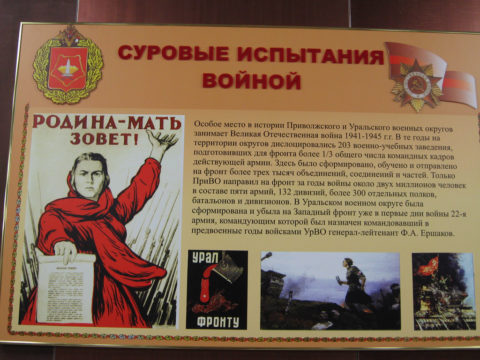
“Mother Russia” by topsafari is licensed under CC BY-NC-ND 2.0
I’ve been in homes that have displayed unusual artwork, including one house decorated in African-themed pieces that many would consider pornographic. But I don’t believe I’ve ever seen anything quite as unusual and unique as the art in Jordan Peterson’s home.
To be clear, I’ve never actually visited Peterson’s house. But his home and its artwork are described in some detail by Norman Doidge, who wrote the foreword to Peterson’s best-selling book 12 Rules for Life.
Doidge met Peterson in 2004 at a gathering hosted by mutual friends, a pair of Polish emigres who came of age during the days of the Soviet empire. At the time, Peterson was a professor at the University of Toronto, and he and Doidge — a psychiatrist and psychoanalyst — soon became friends. (Apart from their scientific interests, it seems the men shared a passion for the great books, particularly “soulful Russian novels”.)
Doidge visited Peterson on more than one occasion, and he describes the Peterson house as “the most fascinating and shocking middle-class home I had seen.” Among the fascinations was an impressive collection of unusual artwork.
“They had art, some carved masks, and abstract portraits, but they were overwhelmed by a huge collection of original Socialist Realist paintings of Lenin and the early Communists commissioned by the USSR,” writes Doidge. “Paintings lionizing the Soviet revolutionary spirit completely filled every single wall, the ceilings, even the bathrooms.”
Books and art can tell you a great deal about people, as I said, but one must be careful to not draw the wrong conclusions. Which invites an important question: Why was Peterson’s home covered in Soviet era artwork?
One might assume that Peterson was a socialist. Yet, this is not the case. Or maybe, one might guess, Peterson began gobbling up Soviet propaganda pieces following the fall of the Soviet Union simply as investment. (I wish I had possessed the foresight to buy up a bunch of vintage Soviet art following the fall of the Soviet empire; alas, I was only 12.) Perhaps, but this wouldn’t explain why it’s displayed throughout his home.
Fortunately, Doidge offers us an answer.
“The paintings were not there because Jordan had any totalitarian sympathies, but because he wanted to remind himself of something he knew he and everyone else would rather forget: that over a hundred million people were murdered in the name of utopia,” Doidge writes.
Avro Canada CF-105 Arrow; Footage from its first flight
Polyus Studios
Published 7 Jul 2020Full documentary is still in development, enjoy the teaser!
(more…)
QotD: Herodotus as Spartan propagandist
The greatest military asset the Spartans had was not actual military excellence – although, again, Spartan capabilities seem to have been somewhat better than average – but the perception of military excellence.
Herodotus seems to be at the start of it, at least in our sources – he relates a story where, after an embarrassing failure in an effort to reduce tiny Tegea to helotage (the Tegeans kicked the Spartans’ asses) in the mid-sixth century, the Spartans supposedly stole the bones of the hero Orestes. Consequently, Herodotus notes, the Spartans were from that point on able to always beat Tegea and subdued the Peloponnese (Hdt. 1.68), resulting in the creation of the Spartan-led Peloponnesian League. The unbeatable Spartans thus appear. It’s possible the Spartan reputation predated this, but – as we’ll see – Herodotus will be the one who codifies that reputation and cements it.
Except, hold on a minute – how hard was it to subdue the Peloponnese? It seems to have been done with a fairly adept mix of diplomacy and military force (champion one side in a local dispute, beat the other, force both into your alliance, repeat, see Kennell (2010), 51-3 for details). But it is little surprise that Sparta would be dominant in the Peloponnese. Messenia and Laconia together was around 2,600 square miles or so. This is – if you’ll pardon the expression – flippin’ massive by the standards of Greek poleis. More than twice as large as the next largest polis in all of Greece (Athens). Sparta is fully one-third of the Peloponnese (the peninsula Sparta is located on). The remaining two-thirds is home to many other poleis – Corinth, Argos, Elis, Tegea, Mantinea, Troezen, Sicyon, Lepreum, Aigeira and on and on. Needless to say, Sparta was several times larger than all of them – only Corinth and Argos came even remotely close in size. The population differences seem to have roughly followed land area. Sparta was just much, MUCH larger and more powerful than any nearby state by the start of the fifth century.
Sparta thus spends the back half of the 500s as the teenager beating up all of the little kids in the sandbox and making himself leader. When you are upwards of three times larger (and in some cases, upwards of ten times larger) than your rivals, a reputation for victory should not be hard to achieve. And, in the event, it turns out it wasn’t.
Which brings us back to Herodotus […] because he isn’t just observing the Spartan reputation, Herodotus is manufacturing the Spartan reputation. Herodotus is our main source for early Greek history (read: pre-480) and for the two Persian invasions of Greece. Herodotus’ Histories cover a range of places and topics – Persia, Greece, Scythia, Egypt – and contain a mixture of history, ethnography, mythology and straight up falsehoods. But – as François Hartog famously pointed out in his The Mirror of Herodotus (originally in French as Le Miroir d’Hérodote), Herodotus is writing about Greece, even when he is writing about Persia – those other cultures and places exist to provide contrasts to the things that Herodotus thinks bind all of the fractious and fiercely independent Greek poleis. And he is perfectly willing to manufacture the past to make it fit that vision.
Sparta has a role to play in that narrative: the well-governed polis, a bastion of freedom, ever opposed to tyranny, be it Greek or Persian. We’ll come back to Sparta’s … let’s say relationship … with Persian “tyranny” next week. But for Herodotus, Sparta is the expression of an ideal form of “Greekness” and in Herodotus’ logic, being well-governed (eunomia is the Greek term) results primarily in military excellence. For the story Herodotus is telling to work, Sparta – as one of the leading states resisting Persia – must be well governed and it must be militarily excellent. That’s what will make a good story – and Herodotus never lets the facts get in the way of a good story.
(Sidenote: Athens – at least post-Cleisthenic Athens – gets this treatment too. Athens ends up embodying a different set of “Greek” virtues and where Sparta shows its prowess on land, the Athenians do so at sea.)
And so, Herodotus – the myth-maker – talks up the Spartiates at Thermopylae (you know, the brave 300) and quietly leaves out the other Laconians (who, if you scrutinize his numbers, he knows must be there, to the tune of c. 900 men), downplaying the other Greeks. Spartan leadership is lionized, even when it makes stupid mistakes (Thermopylae, to be clear, was a military disaster and Spartan intransigence nearly loses the battle of Plataea, but Herodotus represents this as boldness in the face of the enemy; even more fantastically inept was the initial Spartan plan to hold on the Isthmus of Corinth as if no one had ever seen a boat before).
Bret Devereaux, “Collections: This. Isn’t. Sparta. Part VI: Spartan Battle”, A Collection of Unmitigated Pedantry, 2019-09-20.
March 24, 2022
Making a little shelf from reclaimed wood. No plans.
Rex Krueger
Published 23 Mar 2022You don’t need plans for every project. Learn how I improvised this fast build!
Patrons get all plans for free: http://www.patreon.com/rexkrueger
Get the Marking & Measuring Bundle: https://www.rexkrueger.com/store/mark…
______________________________________________Check out the tools from the Marking & Measuring Bundle:
Roubo Winding Sticks:
Video: https://youtu.be/7Am4jIQgrG0
Plans: https://www.rexkrueger.com/store/plan…Fish-Head Marking Gauge:
Video: https://youtu.be/7_2Sq9M0qck
Plans: https://www.rexkrueger.com/store/plan…Japanese Marking Gauge:
Video: https://youtu.be/q6IoKwB-9Tw
Plans: https://www.rexkrueger.com/store/japa…One Handed Marking Gauge:
Video: https://youtu.be/tm7AFpc02gA
Plans: https://www.rexkrueger.com/store/plan…Shop-Made Try-Squares:
Video: https://youtu.be/AepJXBxOcpk
Plans: https://www.rexkrueger.com/store/plan…
______________________________________________Get My New Book, Everyday Woodworking: https://amzn.to/3oyjC0E
Check out my new site: https://woodworkforhumans.com
______________________________________________Sign up for Fabrication First, my FREE newsletter: http://eepurl.com/gRhEVT?
______________________________________________Wood Work for Humans Tool List (affiliate):
*Cutting*
Gyokucho Ryoba Saw: https://amzn.to/2Z5Wmda
Dewalt Panel Saw: https://amzn.to/2HJqGmO
Suizan Dozuki Handsaw: https://amzn.to/3abRyXB
(Winner of the affordable dovetail-saw shootout.)
Spear and Jackson Tenon Saw: https://amzn.to/2zykhs6
(Needs tune-up to work well.)
Crown Tenon Saw: https://amzn.to/3l89Dut
(Works out of the box)
Carving Knife: https://amzn.to/2DkbsnM
Narex True Imperial Chisels: https://amzn.to/2EX4xls
(My favorite affordable new chisels.)
Blue-Handled Marples Chisels: https://amzn.to/2tVJARY
(I use these to make the DIY specialty planes, but I also like them for general work.)*Sharpening*
Honing Guide: https://amzn.to/2TaJEZM
Norton Coarse/Fine Oil Stone: https://amzn.to/36seh2m
Natural Arkansas Fine Oil Stone: https://amzn.to/3irDQmq
Green buffing compound: https://amzn.to/2XuUBE2*Marking and Measuring*
Stockman Knife: https://amzn.to/2Pp4bWP
(For marking and the built-in awl).
Speed Square: https://amzn.to/3gSi6jK
Stanley Marking Knife: https://amzn.to/2Ewrxo3
(Excellent, inexpensive marking knife.)
Blue Kreg measuring jig: https://amzn.to/2QTnKYd
Round-head Protractor: https://amzn.to/37fJ6oz*Drilling*
Forstner Bits: https://amzn.to/3jpBgPl
Spade Bits: https://amzn.to/2U5kvML*Work-Holding*
Orange F Clamps: https://amzn.to/2u3tp4X
Screw Clamp: https://amzn.to/3gCa5i8Get my woodturning book: http://www.rexkrueger.com/book
Follow me on Instagram: @rexkrueger

